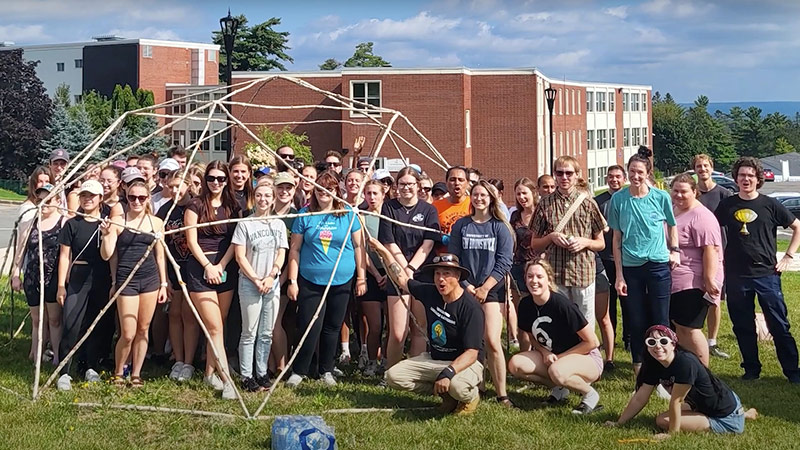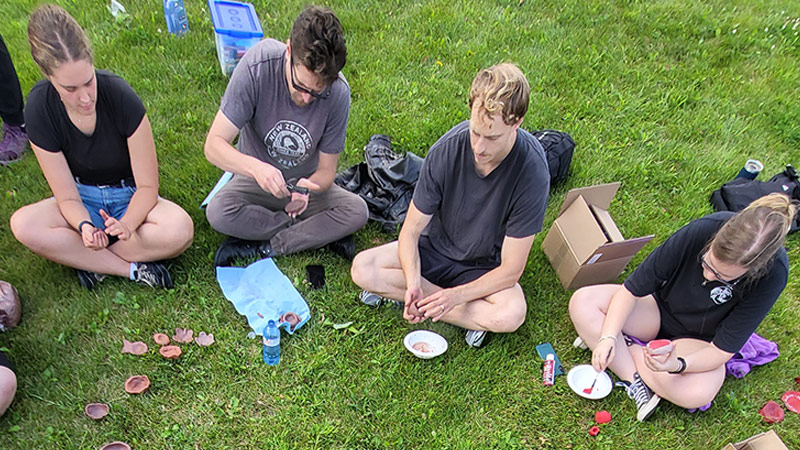UNB education students embrace Indigenous wisdom
Author: Tim Jaques
Posted on Mar 27, 2024
Category: UNB Fredericton

In an initiative aimed at fostering Indigenous understanding and reconciliation, 98 bachelor of education degree students from the University of New Brunswick’s (UNB) Fredericton campus embarked on a transformative journey guided by Wabanaki Elders and Knowledge Keepers.
In a course called Indigenous Education, students learned through experience an Indigenous pedagogical approach that includes learning on the land with Elders.
The intent of this experience is to gain knowledge and insight and apply it to addressing Indigenous issues and promoting reconciliation and decolonization within the educational landscape of the school systems where they will soon teach.
“This is one of our core values in the faculty of education,” said Andrea Belczewski, associate dean of undergraduate programs in the faculty of education.
“The term is ‘Piluwitahasuwawsuwakon’ (pronounced “bill-wee-duh-huz-zoo-wows-sue-wah-gn"), which was gifted by a former Elder-in-Residence to replace ‘Indigenization.’ It literally means ‘allowing our thinking to change so that our actions will follow in a good way toward truth,’” Belczewski said.
“So, in light of the Truth and Reconciliation Commission of Canada's calls to action for education, this course has become required for all education students.”
The course consists of three pedagogies: land-based learning, service learning and experiential learning.
“Land-based pedagogy is an Indigenous pedagogy that allows participants to connect with what it means to be in a relationship with nature, culture, language and tradition,” said Juan Rodriguez, an associate professor at the Mi’kmaq-Wolastoqey Centre (MWC).
“It is mainly delivered by Indigenous Elders and Indigenous Knowledge Keepers and other Indigenous academics and scholars,” he said.
There is also an orientation at which the students meet an Elder and take part in a sweetgrass smudging ceremony.
“We inform the students of proper protocols when approaching Elders and with participating in a talking circle,” said Natasha Simon, Nihkanatpat (director) of the MWC and assistant professor in the faculty of education.
“We had Elders visit with them in the class to discuss this topic as well,” she said.
“I told them to be good treaty partners and as treaty partners, to create that space for Indigenous ways of knowing.”
Rodriguez said in service-based learning, students focus on how they can combine learning with serving Indigenous communities. In this case these are Wolastoqey and Mi’kmaq communities, part of the Wabanaki Confederacy, a historic alliance between the Wolastoqey, Mi’kmaq, Peskotomuhkati, Abenaki, and Penobscot Nations.
Two past examples of this were helping to plant about a thousand trees with the Nashwaak Watershed Association and planting sweetgrass for ceremonial use at the Wabanaki Resiliency Lodge in Gagetown with Elder Alma Brooks.
Students also work on the Wabanaki longhouse on UNB’s Fredericton campus.
The experiential and work-integrated learning aspects of the course showed how non-Indigenous students can support and connect with Indigenous peoples and communities, in grounded, authentic and meaningful ways.
“This way they can design a curriculum, consult with Indigenous communities and consult with Elders, so they will be able to do it in their future schools and their future work,” said Rodriguez.
“Part of the pedagogies is understanding correct protocols, understanding one's place, one's relationship, and how to do this honourably with appreciation and not appropriation,” Belczewski added.
Rodriguez said many students arrive with little knowledge of Indigenous cultures.
“That’s why one of the goals of the course is just to provide them with correct information and how to respond to things like the calls to action, reconciliation in Canada, or the residential schools report, and how to transform the curriculum in their schools in their future work.”
Students also take part in National Truth and Reconciliation Day at UNB’s Fredericton campus and engage in creative exercises to reflect on what it means to be part of the process, and how they recognize the need for change in pedagogies and curriculums throughout the education system.
This year, students created ceremonial candleholders and hand-painted clay tiles with depictions of birds.
The candleholders were part of the Red Shawl Campaign to raise awareness of missing and murdered Indigenous women and girls, with each candleholder having the name of a missing or murdered Indigenous woman or girl.
“I chose to include a red handprint on my clay candle because the voices of Indigenous women need to be heard,” said education student, Zoey Levesque, explaining that it “symbolizes the thousands of Indigenous women who have been silenced.”
The birds represented children and residential school survivors and were presented at UNB’s observance of National Truth and Reconciliation Day.
Birds symbolize strength in their ability to continue, even when their journey may be difficult.

“Activities like these involve different levels of learning: emotional, cognitive, relational and socio-cultural. The students will be able to participate in those ceremonies, listening for the first time to Indigenous survivors from residential schools and learning about the harms, connecting with the past that we have in Canada, and promoting reconciliation,” said Rodriguez.
“[The] tribute bird serves as a visual reminder that healing begins with acknowledging the depths of pain, loss and suffering endured by Indigenous communities throughout history,” said education student Breanne Jones.
Students also learn about the history of and issues facing Indigenous peoples in other parts of Canada.
“In my teaching practice, I plan to be an educator who is well-versed in Indigenous culture so that I can confidently include it into my lessons on a consistent basis,” said education student Alexa Rumble.
“I think that including Indigenous knowledge and ways of knowing consistently will allow both myself and my students to better understand the world around them.”
The course structure is well-developed, and Simon wants to see it grow.
“I propose to expand on the treaty education components. It is crucial for students to have ample time to comprehend and acclimate to Wabanaki approach to treaty making,” she said.
“Additionally, integrating more information about sharing circles as a pedagogical approach would enhance the learning experience.”
While the Indigenous Learning course received $55,000 in funding from Co-operative Education and Work-Integrated Learning Canada (CEWIL Canada), Rodriguez said they are looking for additional funding.
“The course prepares our students to work in the field by incorporating Indigenous education, Indigenous standards, Indigenous consultation, and community processes and protocols,” he said.
“Our goal is to prepare them to be the changemakers of the curriculum in their schools and involve Indigenous communities.”
UNB is a centre for experiential education connecting students with industry and the community, building a skilled, qualified workforce for tomorrow. This month, we are sharing stories of students deepening their learning outside the classroom, discovering their passions and making meaningful change in the world around them.
Other stories in the series:
